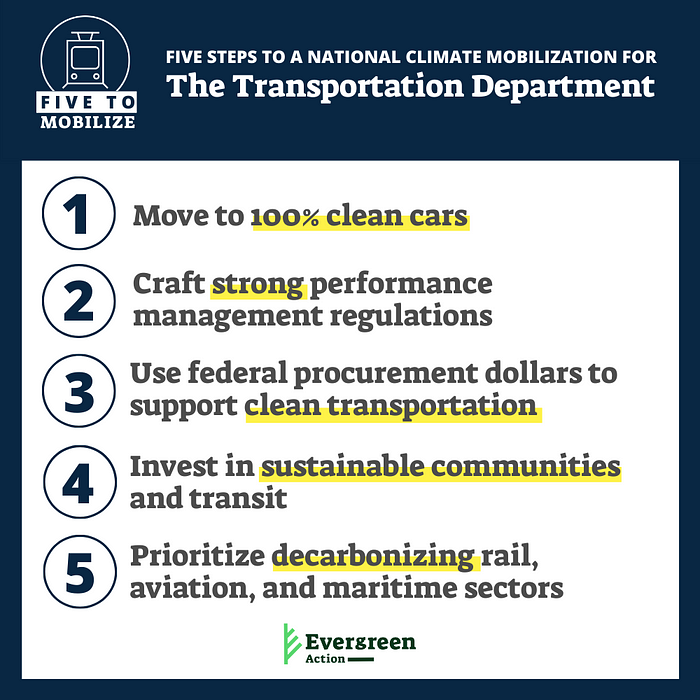5 Action Steps for the Department of Transportation To Lead National Mobilization To Defeat the Climate Crisis

Americans have spent the last 4 years hearing broken promises about Infrastructure Week. Now, the Biden Administration has the opportunity to make every week Clean Infrastructure Week as a central part of a national climate mobilization.
The Department of Transportation is critical to America’s climate policy. The USDOT oversees the single largest source of pollution in the U.S. economy. Transportation has always been an agency with climate effects — now it must become a climate agency.
The USDOT must act rapidly to meet President-elect Biden’s ambitious campaign commitments. The agency should enact strong clean energy and performance standards to ramp up the deployment of zero emission vehicles. And the USDOT must prioritize expansion of electrified rail, shipping and aviation. The climate crisis is also a crisis of mobility. USDOT can revitalize our communities and aid working class people through serious investments in sustainable public transportation. A clean transportation sector will also create high quality union jobs in domestic manufacturing. These steps are not only critical to fight the climate crisis, they will drive economic recovery.
The Secretary of Transportation must be a leader in the full-government mobilization to defeat the climate crisis. Pete Buttigieg has a responsibility to act with boldness and urgency. On the campaign trail, Buttigieg spoke of the climate crisis as an existential one. Now he has a huge opportunity to act on that commitment in this major role.
In order to realize Biden’s climate mandate, every federal agency must become a climate agency. The Department of Transportation will be critical in this effort. Today, Evergreen Action is releasing 5 concrete actions that the next Department of Transportation must deliver in the all-out government mobilization to defeat the climate crisis:

1. Move to 100% Clean Cars
The Department of Transportation (USDOT) must play a central role in fulfilling President-elect Biden’s vision for a clean transportation sector. In particular, to decarbonize transportation at the rate demanded by science, USDOT, through the National Highway Traffic Safety Administration (NHTSA) should restore Obama-era fuel economy and tailpipe greenhouse gas performance standards through 2026, and work with other federal partners to restore California’s clean cars waiver. USDOT must then work closely with the Environmental Protection Agency (EPA) in developing post-2026 rules that institute increasingly stringent tailpipe standards on the march to ensuring that 100% of new sales for light- and medium-duty vehicles and buses are zero emission vehicles by 2030, and heavy-duty vehicles shortly thereafter. The Biden-Harris administration should also prioritize investments in high-quality union jobs in domestic clean car manufacturing and charging infrastructure.
2. Craft Strong Performance Management Regulations
The Secretary of Transportation must lead in instituting stringent new greenhouse gas performance management regulations that require local deployment of federal transportation investments be accompanied by comprehensive life-cycle analyses and reduction strategies for climate pollution and co-pollutants. In addition, USDOT should update NEPA guidance to account fully for climate risks and impacts of USDOT projects — to ensure America’s 21st century transportation infrastructure is not contributing to nor vulnerable to increasing climate disasters.
3. Use Federal Procurement Dollars to Support Clean Transportation
USDOT must work with the Department of Energy (DOE), General Services Administration (GSA) and other federal and subnational partners to ensure that federal procurement dollars for federal, state, tribal, postal, and local public sector vehicle fleets are spent on clean energy and zero emission vehicles. And that these purchases continue to drive innovation and domestic union manufacturing jobs building the clean cars and industries for global 21st century transportation networks.
4. Invest in Sustainable Communities and Transit
Under the new secretary, USDOT should relaunch and expand the Obama-era Sustainable Communities Initiative — a partnership with the EPA and Department of House and Urban Development (HUD) that provides technical assistance and financial incentives for strong local zoning ordinances that include climate-resilient and transit-oriented community projects.
5. Prioritize Decarbonizing Rail, Aviation, and Maritime Sectors
The new Transportation Secretary must recognize that integrated and electrified rail is essential to a clean transportation future. President-elect Biden committed to tap existing USDOT loan programs, and to improve and streamline the loan process, to help expand rail transit and to further electrify the rail system. USDOT, through the FAA, should also work with airlines to meet and exceed the Carbon Offsetting and Reduction Scheme for International Aviation, while simultaneously developing a companion domestic program and targeting policies to promote innovation and deployment of new technologies and energy efficiency upgrades in aviation. And USDOT must establish partnerships to help the shipping industry meet and exceed the International Maritime Organization pollution reduction goals.
